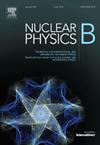弹跳宇宙学与f(R,Lm)-重力的动力学稳定性分析
IF 2.5
3区 物理与天体物理
Q2 PHYSICS, PARTICLES & FIELDS
引用次数: 0
摘要
我们研究了f(R,Lm)引力理论中的弹跳宇宙学。在这个模型中,我们考虑一个特定的函数f(R,Lm),它包含高阶曲率项和物质拉格朗日量。在这里,我们将哈勃参数参数化,其动机是创建一个具有弹跳行为的模型,并解决宇宙早期演化过程中的初始奇点问题。这个模型实现了弹跳,宇宙迅速收缩,然后迅速膨胀。EoS参数在弹跳位置附近越过quinquinline,表明模型中的能量密度、各向同性压力和温度发生了显著变化。模型在弹跳点附近高度不稳定。最后,通过对声速和绝热指数的描述,分析了模型在弹跳点附近的动态稳定性。本文章由计算机程序翻译,如有差异,请以英文原文为准。
Bouncing cosmology and the dynamical stability analysis in f(R,Lm)-gravity
We study the bouncing cosmology in the theory of gravity. In this model, we consider a specific function of which contains the higher order curvature term along with the matter Lagrangian. Here, we parameterize the Hubble parameter with the motivation that it creates a model with bouncing behavior and solves the initial singularity problem during the universe's early evolution. This model achieves a bounce instead, where the universe rapidly contracts and then quickly expands again. The EoS parameter crosses the quintom line in the vicinity of the bouncing position indicating significant changes in the energy density, isotropic pressure, and temperature in the model. The model is highly unstable near the bouncing point. Finally, we analyze the model's dynamic stability in the neighborhood of the bouncing point by examining the sound velocity and the adiabatic index depictions.
求助全文
通过发布文献求助,成功后即可免费获取论文全文。
去求助
来源期刊

Nuclear Physics B
物理-物理:粒子与场物理
CiteScore
5.50
自引率
7.10%
发文量
302
审稿时长
1 months
期刊介绍:
Nuclear Physics B focuses on the domain of high energy physics, quantum field theory, statistical systems, and mathematical physics, and includes four main sections: high energy physics - phenomenology, high energy physics - theory, high energy physics - experiment, and quantum field theory, statistical systems, and mathematical physics. The emphasis is on original research papers (Frontiers Articles or Full Length Articles), but Review Articles are also welcome.
 求助内容:
求助内容: 应助结果提醒方式:
应助结果提醒方式:


